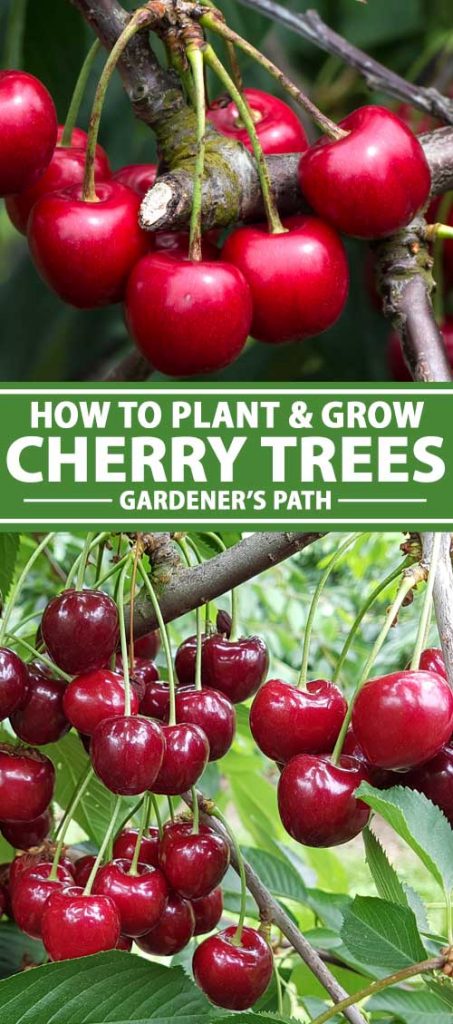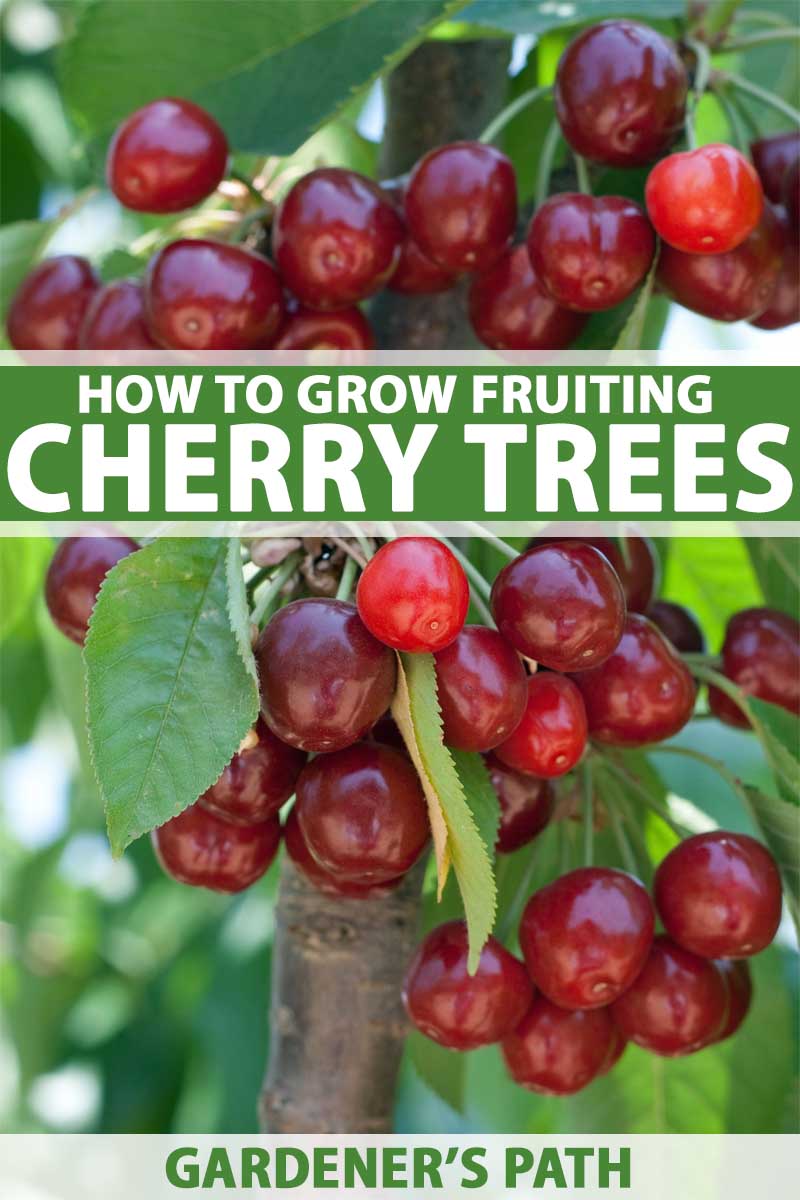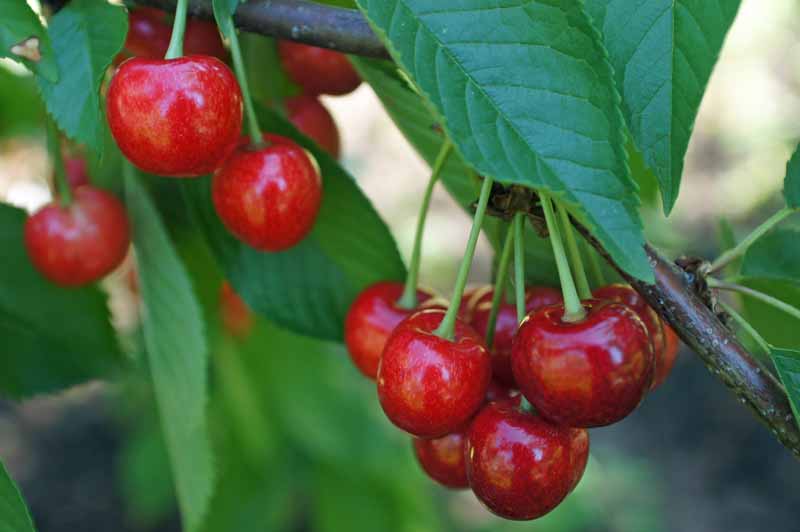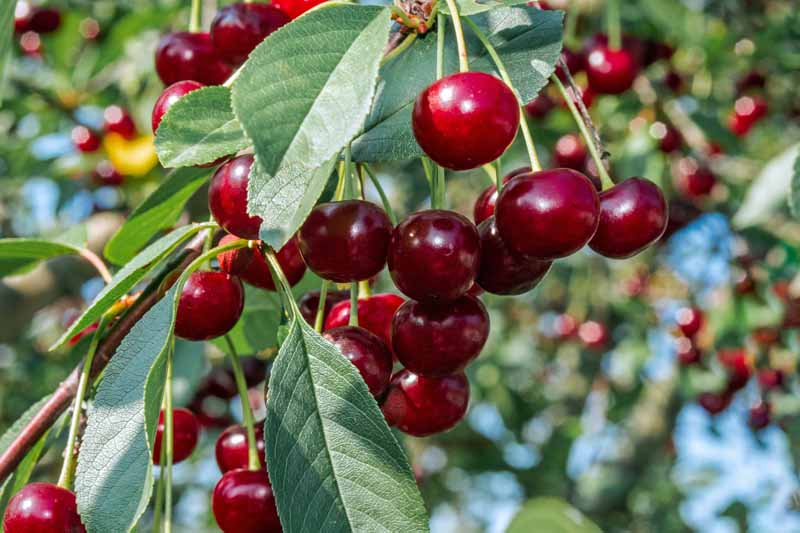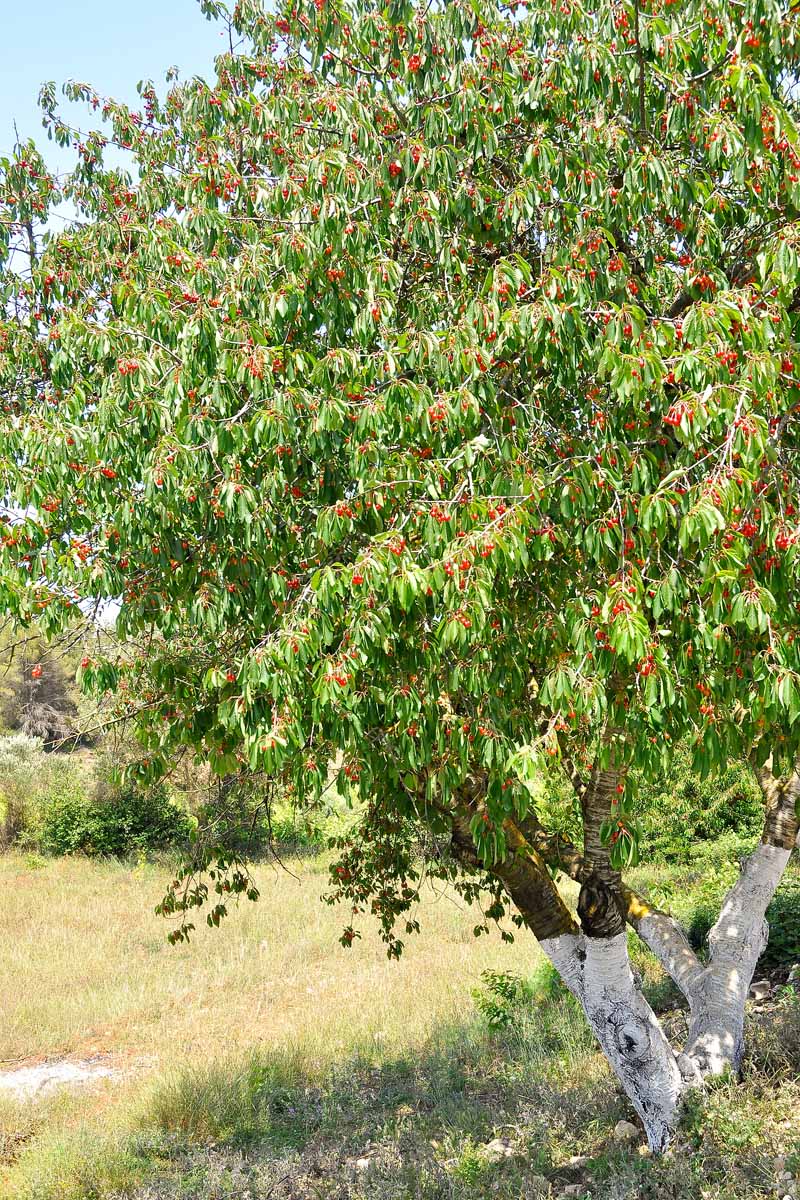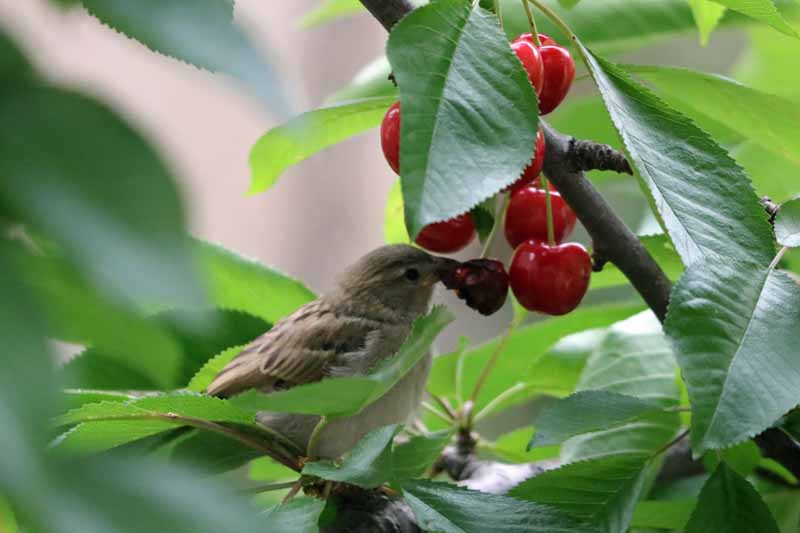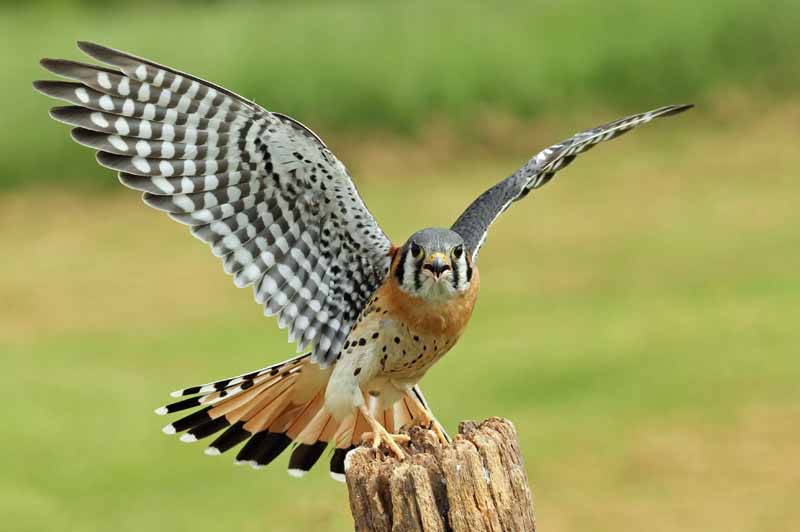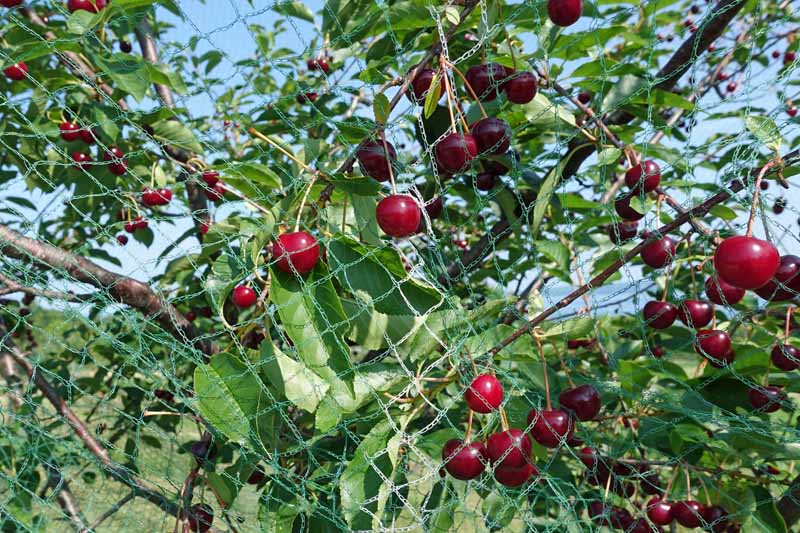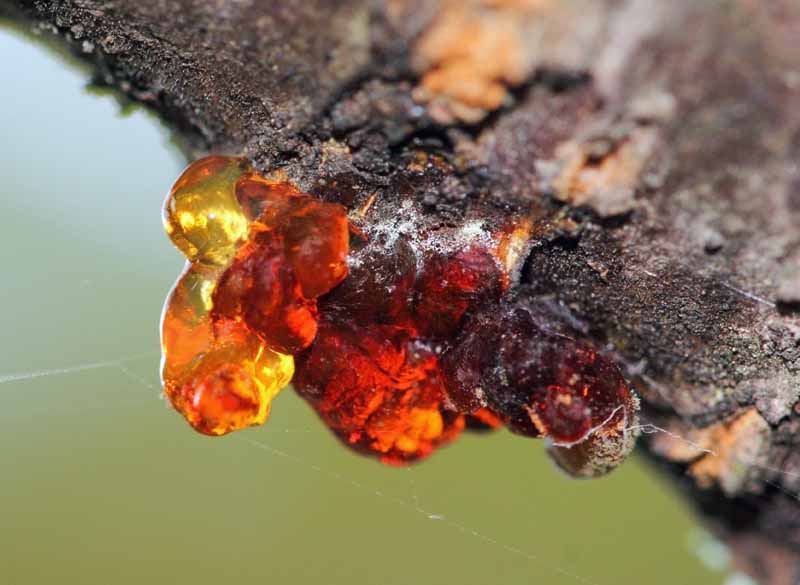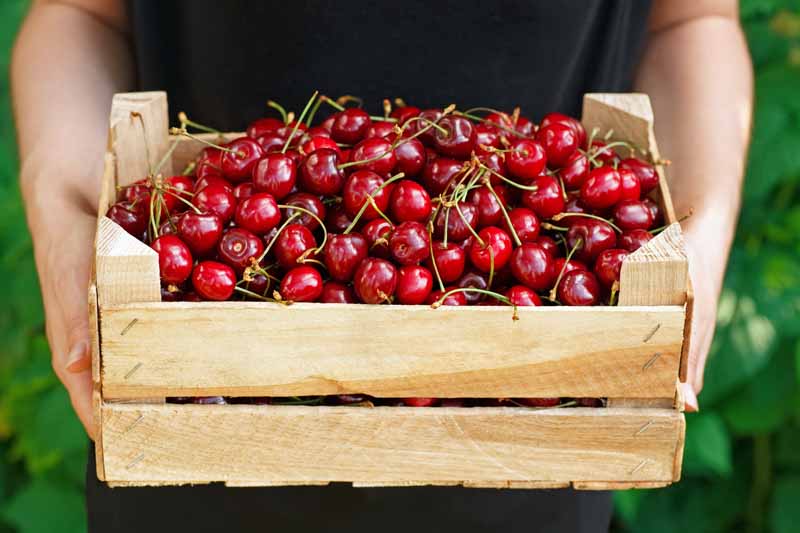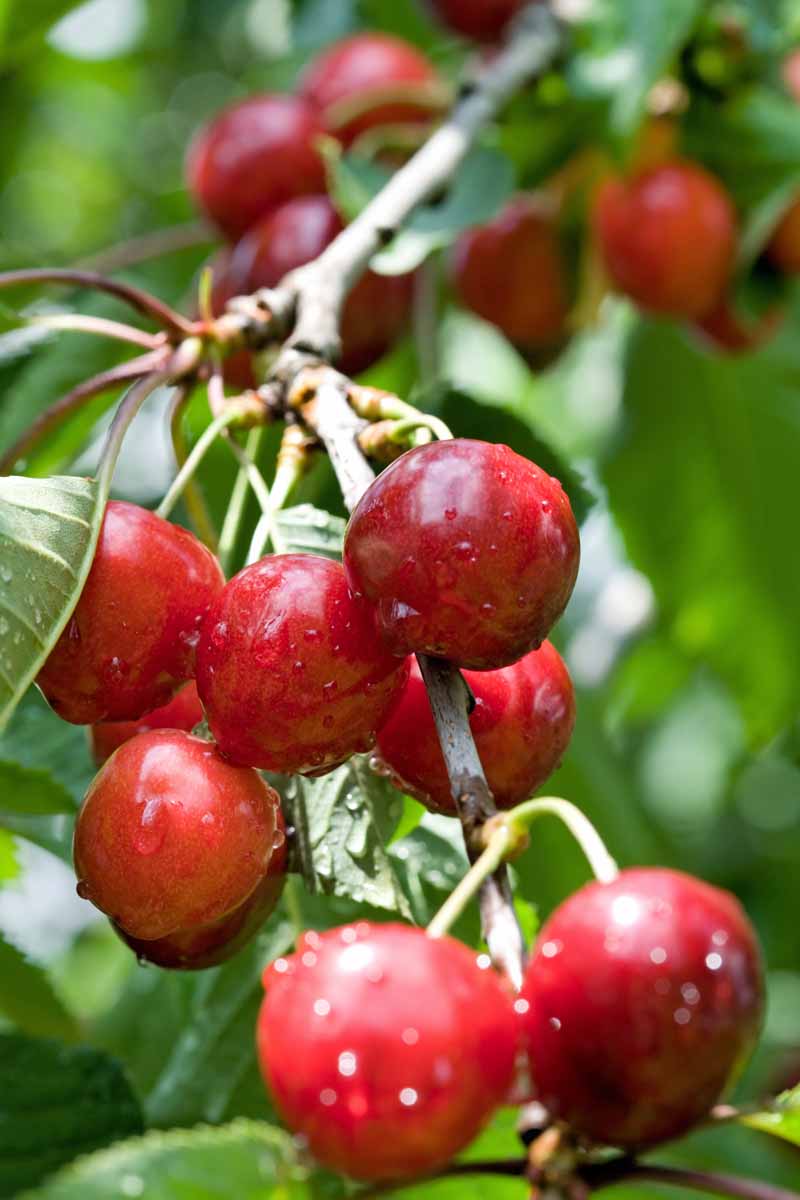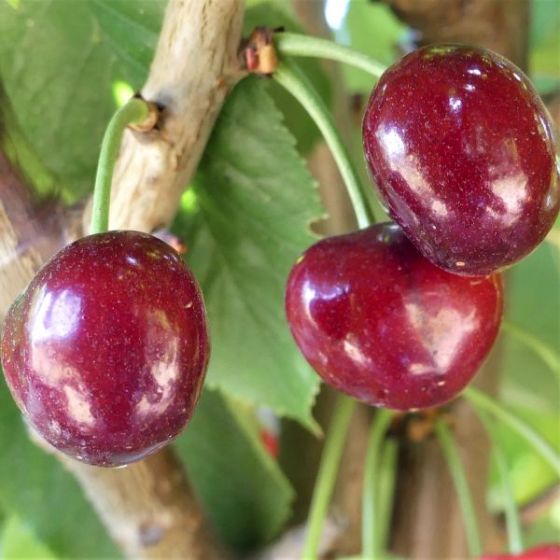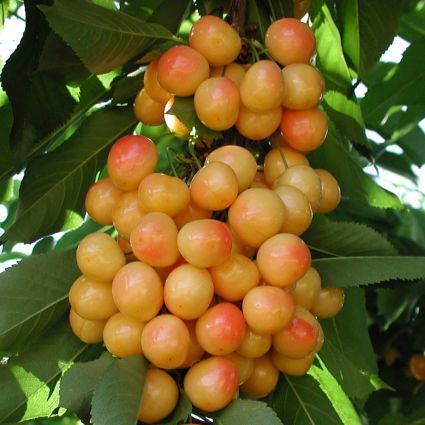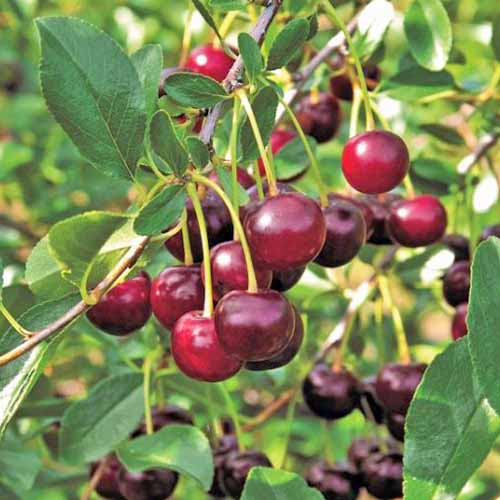In the past I’ve cleaned entire raspberry bushes of edible fruit, snagged a few days’ worth of apples and pears, and passed out with a belly full of strawberries. That last one caused a stir back in the day! This dedication to sun-warmed produce by the bucketful places cherries high on my list of favorite fresh fruit. I was fortunate to grow up near a few cherry trees that were at their peak of production, but since then I’ve helped individuals plant their own trees and may have treated myself to a few of those fruits when they were ripe. We link to vendors to help you find relevant products. If you buy from one of our links, we may earn a commission. Establishing a healthy tree demands some forethought and proper planning that may be intimidating to the casual gardener. But fear not! We’ve put together an excellent guide for how to start growing cherry trees. Check out our list of suggested cultivars, too, for our recommended picks.
What Are Fruiting Cherry Trees?
Cherries are stone fruits which produce “drupes,” or fleshy material surrounding a single seed. They are in the genus Prunus and are closely related to other stone fruits and nut trees such as peaches, almonds, apricots, nectarines, and plums, along with other ornamental flowering trees and wild species.
What Type Is for You?
Fruiting cherries are derived from two different species within the Prunus genus. Sweet cherries (Prunus avium) tend to grow in USDA Hardiness Zones 5 to 7. These fruits are perfect for fresh eating and will produce plenty of fruit each year. The sweet cultivars are self-sterile, so you’ll need to plant at least two or three for fruit production. Sweets also require ample spacing to grow without becoming crowded. Your sweets need to be planted 35 to 40 feet apart, although dwarf varieties need a mere five to 10 feet of breathing room. Sour cherries (Prunus cerasus) will grow in Zones 4 to 6, and are more cold-hardy. Use these fruits when baking and cooking, but less often for fresh eating (they’re called “sour” for a reason!). Most sour cultivars are also self-sterile, so you’ll need at least two or three to produce any fruit. Fortunately, these trees need only 35 to 40 feet of space between one another, while dwarf varieties require about eight to 10 feet. So, to recap: sweet cherries are for fresh eating and baking, while sour cherries are usually used in baking and are not typically eaten fresh.
Patience Is a Necessity
Most fruiting trees take a few years to begin producing something that’s edible and tasty, and cherries are no different. Expect a period of three to five years of waiting before your trees start producing fruit. The trees need to establish themselves in their new home and gain a solid foothold before they can begin to produce fruit.
A timeline of several years is all the more reason to get started with planting now! What’s that? “But I love the taste of sour cherries…” Me too! Chances are you’ve found them frozen at the grocery store and labeled as ‘Bing’ cherries. If you’re lucky, you’ve also been able to find them fresh in the middle of summer at the farmers market, often towards the end of July. Grow your own and have the freshest crop available for the beautiful window when they’re ripe. With the size of the crop you’ll get, you’ll be able to share them with friends and neighbors too!
Planting Best Practices
Whether you’re planting sweet or sour, both types want similar conditions. Proper soil is critical to the health of your trees. For some species, you can dig a hole and plop the root ball into it, and let the plant do the rest of the work. Cherries, on the other hand, need deep and well-drained soil; this can make planting in rocky areas or soils with a high clay content problematic. I’d recommend digging the hole deeper and wider than it needs to be for the root ball to fit inside. Really break that soil up and replace about one-quarter of the native soil with compost to give the plant a chance to set roots and spread into its new home. Full sun is important for any fruit tree, so place your plant where it will be sure to get at least eight hours of sun a day. A bit of protection from the hottest afternoon sun can be helpful on the more southern edges of the growing zones. Sour varieties are at their best in soil with a pH of 6 to 7, while sweet cultivars prefer a pH of 6.3 to 7.2. They’ll grow in other acidic or basic conditions beyond these recommendations, but prefer this narrow range. Get your soil tested so you’ll have a good starting point before selecting varieties.
Water and Nutrient Requirements
For all of the fruit these trees produce, they don’t require much in the way of fertilizers and water. About an inch of rain per week is ample. Use a rain gauge that sacrifices style in exchange for an easy-to-read and practical setup. The branches are slowly adjusted so that they grow in a completely horizontal shape, which makes them easier to pick and easier to cover with bird netting. Espaliering also promotes airflow and exposure to sunlight, which promotes ripening and helps to prevent fungal infections.
If you’re in a dry spell and aren’t reaching that rain requirement, you can water once a week. However, don’t over saturate the roots and soil; dry roots are healthier than waterlogged ones. A good soaking once a week during periods of dry weather is plenty. Fertilization is even easier. Because cherries are low feeders, you can get away with any of the following fertilization methods:
Use a low nitrogen fertilizer, or a general-purpose fertilizer at half the recommended rate, once a year before flowers bloom. Add twice-yearly application of compost. A light dressing will do the trick.
Easy enough, right? If you like to feed your plants, you can get away with one more application of a granular fertilizer after the plants stop producing fruit.
Pruning and Thinning
Fortunately, you don’t need to thin the fruit, since this is a plant that does that on its own. And that takes a load of effort off your back! Pruning should be done twice a year, once in early spring (before buds break but after threat of a cold snap), and once in later summer. The early spring pruning is when you make more aggressive cuts and remove limbs and large branches. This is intended to provide the tree with a few strong limbs for bearing fruit, instead of many weak limbs that cannot support the weight of fruit. Late summer pruning, aka “thinning,” is intended to clean up the canopy and to increase air circulation as a preventative measure to protect against fungal infections. We aren’t shaping the tree during this time and are only opening things up; make only a few cuts when pruning in late summer. Again, your goals during late winter or early spring pruning are to shape and to make aggressive cuts, and in late summer you want to focus on opening up the canopy for airflow.
Pests
Unfortunately, plenty of critters enjoy cherries as much as we do, so you’ll have to keep your eyes peeled for their presence on your trees. You’ll have a chance to find aphids, various caterpillars, Japanese beetles, thrips, mites, leafhoppers, borers, and the cherry fruit fly. You can use a product like a general fruit and nut orchard spray to control all of these buggies. Select one that contains sulfur to control fungal diseases, and pyrethrins to control insects – but understand you’ll potentially be damaging beneficial insects as well if you resort to this option. Neem oil is another solution that targets insects. It is organic, but keep in mind that organic doesn’t necessarily mean non-toxic. And it will also harm beneficial insects just like the manmade pyrethrins will.
Disease
Powdery mildew, galls, cankers, a host of rots and fungi, and buckskin are fungal issues and diseases that can cause you grief with your fruit production. These problems are more difficult to identify and control than common pests. A horticultural oil is good for removing most plant ailments, while copper fungicide is an excellent organic method for taking care of fungal issues and various cases of rot.
Preventing Bird Damage
It’s a miracle birds can take flight after feasting on an upcoming crop of cherries, with their bellies full of partially developed fruit. Worse yet is when they pick and peck at each individual fruit, leaving behind a rotting mass that’s still attached to the stem. The University of Vermont Department of Plant and Soil Sciences suggests a few excellent methods of preventing bird damage. These include:
Wrap the tree in bird netting Tye reflective tape to branches to distract and disorient birds Use a dummy owl/hawk and move its location daily Eliminate insects on the branches to deter birds Install a birdhouse to attract the predatory kestrel Plant wildflowers like echinacea and rudbeckia to give birds an easier meal
No one method works better than the others, so swapping between different preventatives is the best solution to keeping your plants healthy and full of fruit. Also keep in mind the inherent dangers to wildlife when using bird netting. It’ll keep the critters out, but those hapless ones who get stuck are almost guaranteed to die. I’ve pulled out too many dead birds and chipmunks from bird netting to ever use it at my own home, but it does work to keep your fruit harvest safe from damage. Another tip with bird netting is to install it just before the fruit begins to appear on your plants. If you install it early and keep it in place from the start of the season, birds are likely to learn how to get inside, essentially making the netting worthless as a barrier.
Gummosis
Another condition common in fruit trees and especially cherries is called “gummosis.” Cherry trees release a resin-like sap when they’ve been injured. Sometimes a yard tool damages the trunk and the tree will react by expelling this thick sap to plug and heal the wound. Most of the time these injuries are minor, and the tree can fix itself right up. However, other times the sap expulsion can be caused by borers or cankers. If you discover sawdust around the base of the trunk and beneath the site of the sap, you likely have borers; spray your tree for borers with an appropriate fruit and nut orchard spray. If there is no presence of sawdust, pull away the sap and check the bark. If it’s dead and brittle, you’ve got some cankers to contend with. Cut them out and remove them, or call a professional to do it for you in the event that you’re hesitant to start cutting into the wood. Other causes for gummosis can be fungal in nature, specifically Cytosporina and Phytophthora types of fungus. These are more serious issues to contend with and require careful removal of infected tissue and an application of a fungicide to control. Get a head start on these issues by removing dead limbs and branches in the winter and disposing of them. Read more about gummosis in fruit trees here.
Harvesting
It can take three to five years before your tree will begin to produce fruit, but full-size varieties can produce up to 50 quarts of fruit a year! Dwarf specimens can produce up to about 20 quarts, so that investment in time and patience will certainly pay off in time. Harvest time is between May and August, depending on your locality and the cultivars you are growing.
Determining when they are ripe is a tasty and fun method of experimentation. Research the varieties you’ve planted to find a good, clear image of what they look like when ripe. As your crop is beginning to ripen, take a walk around the tree, find a specimen that looks ripe, then pluck it and eat it! Ripe fruits are firm but tender, and juicy. If the cherry you plucked tastes good, use it as your key to decide if others are also ripe.
Try to maintain a bit of patience when harvesting. The sugar content in the fruit rises significantly in the few days before they fully ripen, and this sugar content does not increase after the fruit is plucked. That makes the best cherry a few days away from being subpar if you’re impatient.
Storage and Preservation
The fruit can be stored for up to a week in dry conditions in the refrigerator, but it declines in quality to a tremendous extent very quickly in room temperature conditions. A few hours at room temperature results in greater loses than an entire day spent in refrigerated conditions! If you aren’t going to eat your harvest right away, stick it in the fridge.
Leave the stems on to maintain their freshness even longer. Pitting the fruit is up to you; I personally enjoy spitting out the seeds, but not everybody does. You can increase the firmness of the fruit after harvest by layering it between paper towels. You can freeze your harvest as well, so long as the fruit has been rinsed and patted dry first. I would recommend purchasing a self-fruiting tree like the ‘Carmine Jewel’ or the ‘Montmorency’ if you have a small and contained area to grow in. Fruit is typically ready for harvest in mid- to late June, but in cooler climates a bit of a delay until the beginning of July isn’t unheard of.
Potted ‘Bing’ Cherry Trees via Nature Hills Nursery The ‘Bing’ type can be paired with ‘Rainier,’ ‘Montmorency,’ and other early pollinators to produce fruit. You can find them for sale at Nature Hills Nursery. ‘Rainier’ is among the most popular and best-tasting out there, so you likely won’t be disappointed from the huge yields and juicy taste that this type can produce.
Potted ‘Rainier’ Cherry Trees via Nature Hills Nursery The fruit ripens in mid-June and can grow in Zones 5 to 9. It reaches a maximum of 25 feet in height and is a good choice for medium-sized yards and growing areas. ‘Rainier’ pollinates with ‘Montmorency,’ ‘Stella,’ and ‘Lambert’ cultivars, and other mid-season varieties. You can find them at Nature Hills. FastGrowingTrees.com has the most popular sour variety in the country for sale, the ‘Montmorency.’
‘Montmorency’ Cherry Tree via FastGrowingTrees.com It will typically grow to about 20 feet in height and is comfortable growing and producing in Zones 4 to 7. As a bonus, it is also self-fertile. If you’ve only got room for one specimen, this could be the one for you! Can’t decide between sweet or sour? Why not grow both? The ‘Carmine Jewel’ is grown on dwarfing rootstock and it does well in Zones 4 to 7.
‘Carmine Jewel’ Cherry in #2 Container, available from Nature Hills Nursery This type is a cross between sweet and sour varieties (P. fruticosa x Pr. cerasus) to provide a harvest to satisfy all tastes, with about 20 pounds of fruit produced on average during its peak production! It is also self-fertile, so really, what’s not to love? You can purchase trees from Nature Hills Nursery. So, which should you get? If you’ve got the room for more, I’d recommend planting the ‘Montmorency,’ ‘Rainier,’ and ‘Bing’ together to ensure a good yield. If you live in Zones 2 to 4 and need a cold tolerant variety, see our guide to the best cold hardy cherry varieties. Like apple trees, cherries have different pollination groups and require other cultivars to be in bloom at the same time.
Quick Reference Growing Chart
Now Get to Plantin’
It takes a while to get there, but when your cherry trees are finally producing pounds and pounds of fruit, you’ll see that it was all worthwhile. Fresh fruit is always delicious, but fresh cherries are at top of the list for taste and flavor. With self-fruitful (and self-unfruitful) options available, you’ve got plenty to pick from and to look forward to. Thanks for reading! Come back again soon, and leave us any questions or insights in the comments below.
